Opensource enterprise resource planning (ERP) is crucial for businesses of all sizes—startups, small businesses, or enterprises—offering cost-effective, adaptable solutions. It enables tailored functionalities, streamlines operations, and facilitates scalability, empowering businesses to compete and innovate effectively in their markets.
At Aloa, we've extensively researched opensource ERP to ensure top-notch reliability and efficiency for businesses, startups, and enterprises. We've curated a comprehensive list of the best opensource ERP platforms and solutions personalized to your requirements. Trust our expertise to guide you in choosing the ideal solution for your business's success.
In this blog post, we'll explore tailored opensource ERP solutions that match your specific requirements. We'll examine the standout features, pricing, and benefits of each platform, with a focus on optimizing their use in your operations. We'll also navigate vital ERP features and the key steps to select the ideal opensource ERP solution, ensuring an effective integration for your needs.
Afterwards, you will have a comprehensive list of options tailored to your requirements. Stay tuned as we unravel the potential of these best opensource ERP solutions, empowering you to make an informed decision in selecting the ideal solution for your success in 2024.
Let’s jump in!
7+ Best Opensource ERP Solutions in 2024
Top opensource ERP solutions revolutionize business operations with flexible frameworks and customizable features. They streamline workflows, optimize resource use, and enable scalability across industries. Let's dive into the best opensource ERP options for startups, businesses, and enterprises seeking efficiency, data management consolidation, and accelerated growth.
1. Microsoft Dynamics 365 Business Central - Managing Businesses Seeking Opensource ERP Functionalities
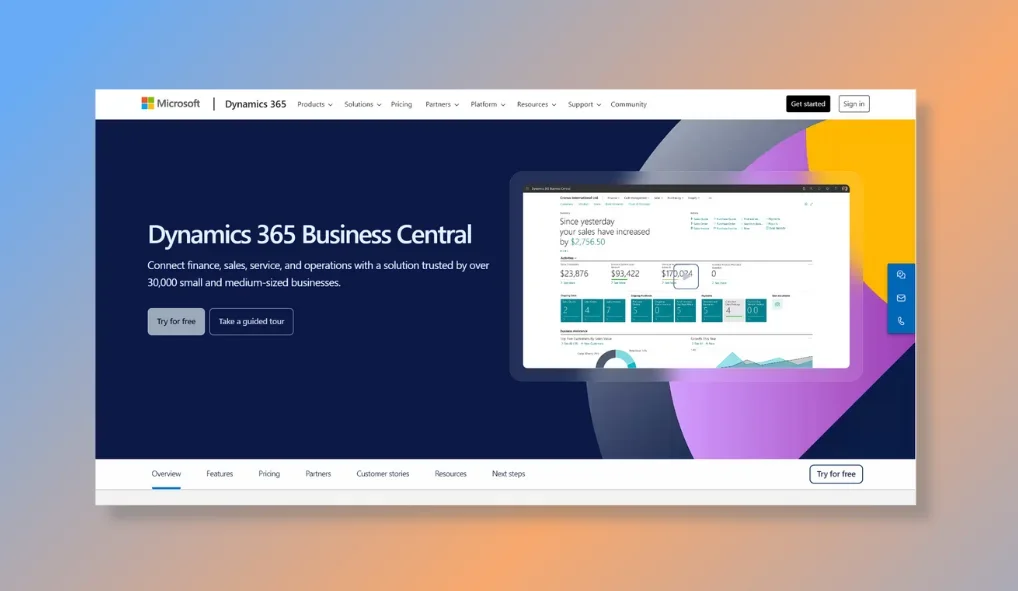
Dynamics 365 Business Central is a leading opensource ERP solution that demonstrates proficiency in integrating finance, sales, service, and operations for small and medium businesses. It is a cloud-based ERP solution that caters to the needs of SMBs and offers features like financial management, supply chain, and inventory management.
The platform facilitates transformative business operations, improving financial performance, boosting sales and service, and optimizing supply chain management. Its openness allows for customization and extension with prebuilt apps, benefiting clients with solutions that adapt to unique business needs, including those seeking top-notch opensource ERP functionalities.
Notable Features of Working with Microsoft Dynamics 365 Business Central
- Adaptability: Business Central's open architecture allows easy integration and extension, making it suitable for businesses seeking premier opensource ERP capabilities.
- Customization: The platform offers tailored solutions through prebuilt apps and extensions like Dynamics 365 customer engagement, ideal for businesses requiring specific functionalities in their opensource ERP systems.
- Scalability: Dynamics 365 Business Central grows with the business, accommodating expanding needs in outstanding opensource ERP functionalities.
- Collaboration: Seamless integration with Microsoft Teams enhances teamwork and communication within the framework of opensource ERP.
Microsoft Dynamics 365 Business Central’s Pricing Plans
To explore Business Central’s pricing plans, visit their website and navigate to the Pricing section tab. You'll find detailed information about their plans tailored to your project requirements.
They cater to small and medium-sized enterprises seeking top-notch opensource ERP solutions. Clients from diverse industries benefit from adaptable, scalable, and open functionalities for their ERP needs.
2. Syspro - Integrating Opensource ERP Systems for Businesses
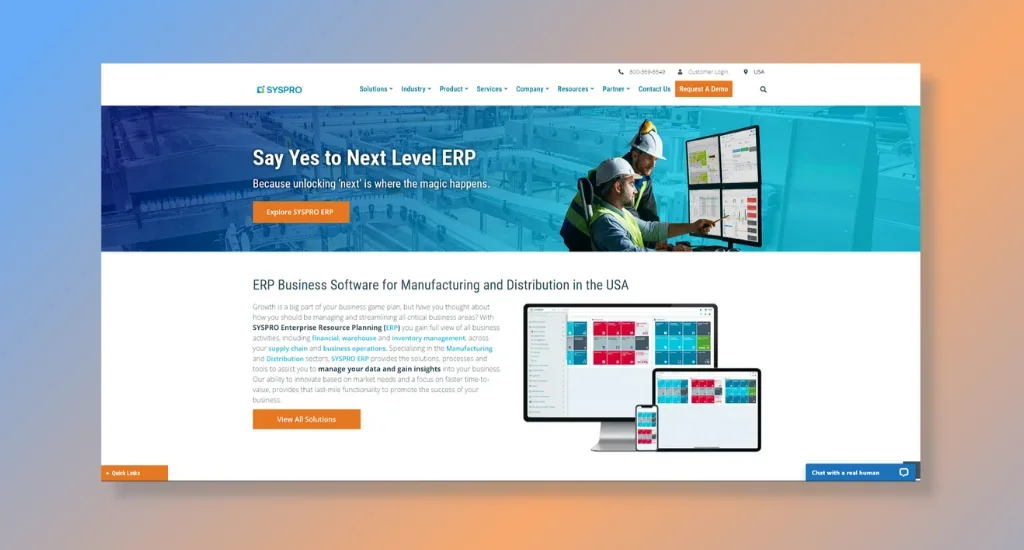
Syspro specializes in providing outstanding opensource ERP solutions tailored to the manufacturing and distribution sectors. Their focus on innovation and faster time-to-value offers last-mile functionality crucial for business success.
Syspro's ERP system assists businesses in managing critical areas like financials, warehouse, and inventory management across the supply chain. They provide tools to streamline data, enhance insights, and drive business efficiency. Clients benefit from improved data management, streamlined processes, and increased profitability.
Notable Features of Working with Syspro
- Open Source Compatibility: Syspro's ERP platform supports integration and customization, enabling compatibility with premier opensource ERP systems.
- Comprehensive Supply Chain Management: Offers robust supply chain tools that complement opensource ERP integration.
- Financial Management: Provides powerful financial modules that can seamlessly integrate with opensource ERP systems.
- Industry-Specific Solutions: Tailors solutions for various industries, enhancing opensource ERP functionality for specific business needs.
Syspro’s Pricing Plans
Syspro's pricing plans vary based on the scale and requirements of the business. You can fill out the contact form on their website to discuss your project requirements with them.
They work with manufacturing, distribution, industrial machinery, and food and beverage businesses. Clients benefit from scalable pricing structures and industry-specific solutions.
3. QT9 - Providing a Scalable Cloud-Based ERP Solution
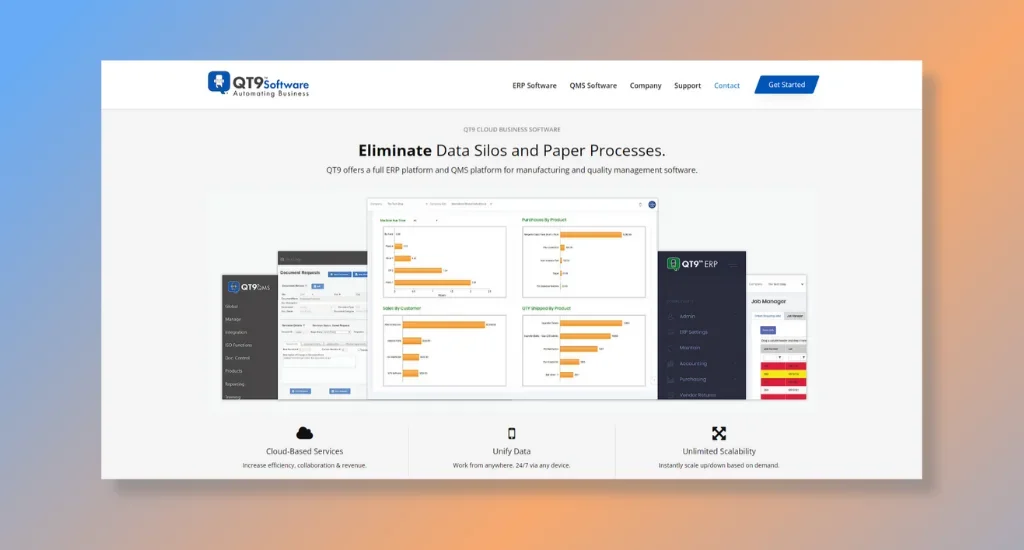
QT9 Software excels in delivering a comprehensive ERP platform, including opensource solutions. They focus on unifying data, providing real-time insights through dynamic dashboards for manufacturing and quality management across aerospace, food, medical devices, pharmaceuticals, and plastics industries.
Their offerings revolve around fully integrated solutions tailored for life sciences, unifying business processes across various sectors. These services include cloud-based deployment options, on-premise installations, and a range of 18+ pre-installed modules covering critical areas like manufacturing, inventory control, sales management, and accounting.
Notable Features of Working with QT9
- Top-Notch Opensource ERP Integration: Seamlessly integrates outstanding opensource ERP systems, enhancing data accessibility and collaboration.
- Scalable Cloud Platform: Offers a scalable cloud environment, allowing businesses to expand or reduce resources based on demand.
- Compliance Management: Provides modules for ISO and FDA compliance, ensuring adherence to industry regulations.
- Real-time Data Visibility: Enables end-to-end traceability, offering real-time insights into transactions and operations.
QT9’s Pricing Plans
QT9 Software offers flexible pricing plans tailored to business needs, including scalable options for small to large enterprises. For the most accurate and up-to-date details on their pricing plans, kindly visit their official website or contact their sales team directly.
They cater to businesses in various sectors such as manufacturing, aerospace, pharmaceuticals, and more, providing the best opensource ERP solutions. Clients benefit from customizable plans that scale with their growth, ensuring cost-effectiveness and tailored solutions.
Best Opensource ERP Solutions for Startups
Opensource ERP for startups is a game-changer for their operational efficiency and growth trajectory. If you're searching for leading opensource ERP solutions for startups, these options can revolutionize how you manage processes and scale your business.
4. Acumatica - Offering Advanced Features and a User-Friendly Interface
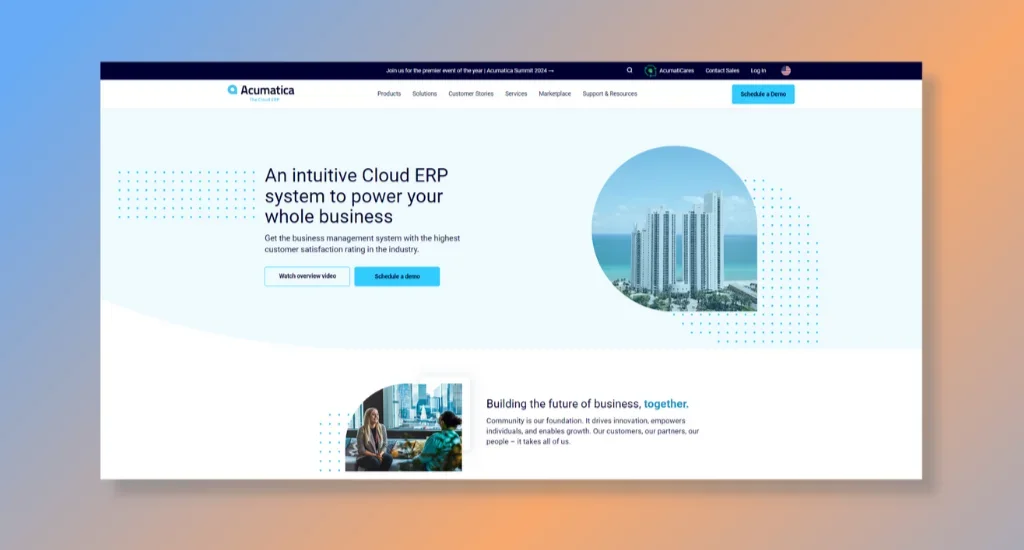
Acumatica Cloud ERP excels in delivering a cloud-based ERP system tailored to the evolving needs of small to mid-sized businesses, including startups. Including a website builder and Google Drive NLP, further boosts Acumatica's ERP usability and accessibility.
They offer startups an opensource ERP system enabling seamless tool integration, enhancing efficiency with an intuitive interface, and fostering collaboration through customizable workflows. Startups benefit from a scalable, no-code environment allowing flexible resource scaling, which is vital for dynamic growth phases.
Notable Features of Working with Acumatica
- Open Integration: Enables startups to effortlessly integrate their existing tech stack with the platform, ensuring smooth operations and data continuity.
- Low-Code Environment: Allows startups to personalize their ERP instance without extensive coding, promoting agility and adaptability.
- Scalability: Offers startups the ability to scale users and resources up or down as needed, accommodating fluctuating business demands.
- Collaborative Workflows: Facilitates seamless collaboration across modules, fostering teamwork and efficiency among startup teams.
Acumatica’s Pricing Plans
Acumatica offers flexible pricing plans tailored to suit varying business sizes and needs, including startups seeking outstanding opensource ERP solutions. You can contact them for inquiries or a product demonstration by visiting their website and filling out the contact form.
They cater to businesses across multiple sectors, including retail, construction, manufacturing, and e-commerce. Clients benefit from customizable plans that align with their specific startup requirements.
5. Deltek - Emphasizing Efficient Management of Project Lifecycles
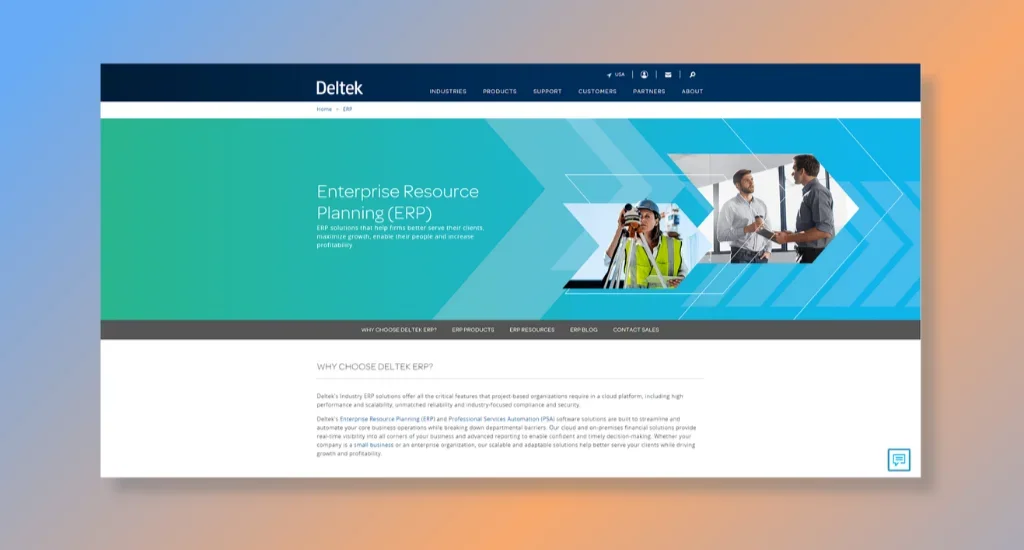
Deltek specializes in tailored ERP solutions for project-based organizations, offering cloud-based platforms that cater to diverse industries. Their expertise lies in providing scalable, adaptable ERP and professional services automation (PSA) software to streamline operations and break departmental barriers.
Their services revolve around purposeful innovation that enhances user experience, boosts performance, and ensures resilience across the project lifecycle. They integrate AI and ML in their ERP solutions for smart automation, predictive analysis, and personalized user experiences, driving efficient decision-making and more innovative project management.
Notable Features of Working with Deltek
- Scalability: Allows startups to scale operations as they grow without compromising efficiency.
- Adaptability: Tailored solutions accommodate specific business needs, ensuring flexibility for startups' unique workflows.
- Financial Visibility: Real-time access to financial performance aids startups in making timely decisions.
- Cloud-Based Access: Offers the flexibility to access mission-critical data anytime, enabling startups to operate efficiently.
Deltek's Pricing Plans
Their pricing plans vary based on the specific ERP solutions tailored for different industries. To contact Deltek's sales team, fill out a form on their website with your details and particular project needs.
They work with startups, offering customizable packages suitable for their scale and needs. Clients benefit from tailored solutions that enable cost-effective management of project lifecycles, aiding startups in achieving financial visibility and scalability.
6. ECI Software Solutions - Offering a Flexible ERP System for Startups
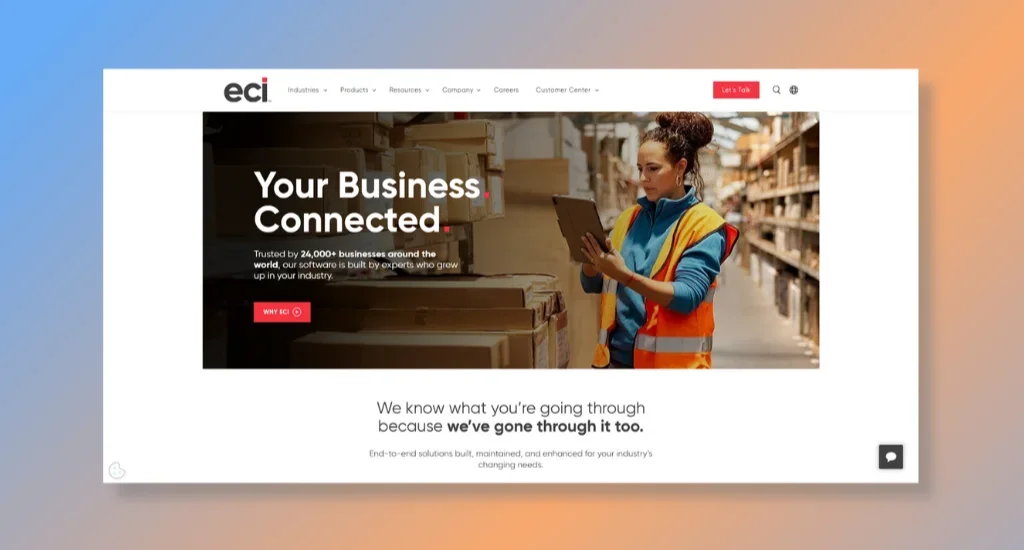
ECI Software Solutions showcases expertise in providing tailored ERP solutions across various industries. Their prowess lies in offering specialized ERP software for manufacturing, distribution, office technology, residential construction, and service management.
Their services revolve around delivering end-to-end solutions that cater to the changing needs of their client's industries. They offer cloud-based ERP solutions that provide security, scalability, and insight similar to larger corporations at cost-effective rates.
Notable Features of Working with ECI Software Solutions
- Open Source Compatibility: ECI's ERP platform offers opensource integration, providing startups with flexibility and customization options.
- Scalability: The platform allows startups to scale their operations seamlessly without incurring additional costs.
- Cost-Effective Solutions: With cloud-based services, startups can reduce IT expenses while benefiting from robust ERP functionalities.
- Industry-Specific Modules: ECI provides tailored modules for various industries, ensuring startups get what they need.
ECI Software Solutions’ Pricing Plans
ECI offers scalable pricing plans tailored to suit businesses of different sizes, including startups. If you're interested in a demo or learning more about their software solutions, contact them through their provided phone number or explore their website for more information, news, and insights.
They cater to startups and businesses across specific industries, including manufacturing, distribution, residential construction, and service management. Clients benefit from the ability to scale without significantly increasing staff needs with their particular industry-focused and integrated suite of applications.
Best Opensource ERP Solutions for Businesses and Enterprises
The best ERP solutions for businesses and enterprises excel in optimizing operations and facilitating seamless management. These ERP solutions are dedicated to driving innovation and supporting scalable growth within expansive organizational frameworks, ensuring sustained success and adaptability for your evolving needs.
7. SAP S/4HANA Cloud - Integrating Industry Best Practices

SAP brings expertise in opensource ERP for businesses and enterprises by offering SAP S/4HANA Cloud, a ready-to-run cloud ERP that integrates industry best practices. Their comprehensive solution allows companies to customize and reshape models on the go, ensuring flexibility and scalability.
They provide businesses and enterprises with a ready-to-run system integrating cutting-edge technologies and industry best practices. Their service ensures seamless customization, scalability, and continuous innovation, empowering businesses to navigate complex environments confidently and efficiently.
SAP consulting experts play a crucial role in this process, particularly for new users of SAP S/4HANA Cloud. They guide businesses in customizing the ERP system to their unique requirements, ensuring optimal use of its full potential.
Notable Features of SAP S/4HANA Cloud
- Customization: Enables businesses to reshape and redefine models effortlessly, ensuring adaptability in a dynamic environment.
- Scalability: Allows seamless expansion of customers, markets, and products without added complexity.
- Continuous Innovation: Integration of cutting-edge technologies like AI, ML, RPA, and analytics for enhanced operational efficiency.
- Open and Extensible: Provides APIs and supporting tools for easy integration with partners or further development, fostering an innovation ecosystem.
SAP S/4HANA Cloud’s Pricing Plans
Their pricing plans vary based on the specific needs and scope of the enterprise. To contact SAP for inquiries or to request a demo of their solutions, you can visit their website and complete the provided form.
They cater to businesses of all sizes, from small and midsize enterprises (SMEs) to large corporations, ensuring scalability and affordability. Clients benefit from a flexible pricing structure that aligns with their growth trajectory, providing value for investment.
8. Sage Intacct - Providing Powerful Analytics for Informed Decisions
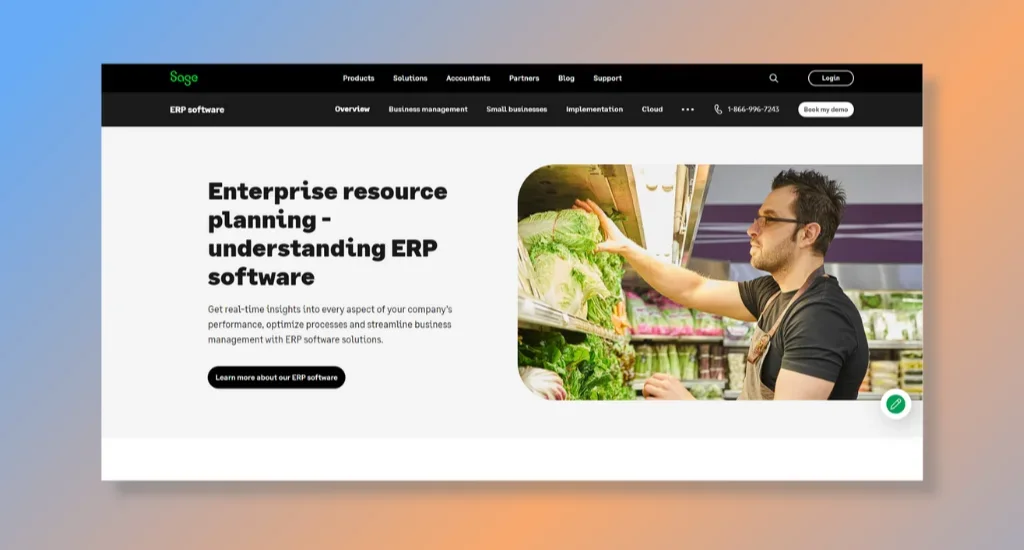
Sage Intacct offers top-notch opensource ERP solutions tailored for businesses and enterprises. Their expertise lies in providing customizable and scalable ERP software that integrates various business processes, including HR, accounting, inventory management, and CRM.
They provide clients access to customizable software that connects the front-office and back-office, facilitating improved decision-making, cost-effectiveness, and operational efficiency. With a focus on scalability and growth, this platform equips businesses with real-time insights to identify areas for improvement and compliance with financial regulations.
Notable Features of Working with Sage Intacct
- Advanced Financial Insights: Sage Intacct offers insights into financial performance through features like Dashboards and Reporting. Real-time visibility empowers data-driven decision-making.
- Automated Processes: The platform streamlines tasks like Accounts Payable and Accounts Receivable, saving time and reducing errors through automation, boosting overall efficiency.
- Multi-Entity Functionality: Ideal for growing enterprises, Sage Intacct's robust support for multiple entities provides powerful insights and management capabilities across complex business structures.
- Cloud-Based Accessibility: Being cloud-based, Sage Intacct allows access from anywhere, anytime, ensuring teams can collaborate seamlessly and enabling flexibility in operations.
Sage Intacct’s Pricing Plans
The platform offers flexible pricing plans for businesses of varying sizes and needs. To book a personalized demo or get in touch with Sage for a demo of their ERP solutions, you can call them directly or fill out the form on their website.
They collaborate with diverse enterprises, including manufacturing, distribution, engineering services, and global industries. Clients benefit from their expertise catering to businesses requiring sophisticated solutions, particularly in opensource ERP for enterprises.
9. NetSuite - Offering Comprehensive Cloud-Based Business Management Solution

NetSuite ERP provides comprehensive cloud-based business management solutions, specializing in streamlining enterprise operations. Its expertise lies in automating core processes, offering real-time financial and operational performance visibility, and facilitating seamless management across multiple subsidiaries and global business units.
NetSuite ERP enables businesses to manage accounting, inventory, order processing, supply chain, and warehouse operations through a unified application. For mid-sized companies rolling out multi-location inventory or businesses shifting from disconnected tools like QuickBooks and spreadsheets, partnering with a Netsuite partner can help map out the right modules, migrate existing data without disruption, and configure industry-specific workflows—whether it’s for wholesale distribution, manufacturing, or eCommerce. Clients benefit from automated financial processes, enhanced inventory visibility, and optimized supply chain management.
Notable Features of Working with NetSuite
- Comprehensive Accounting: Automate general ledger operations, optimize AR/AP processes, and gain complete cash flow visibility.
- Global Business Management: Effortlessly manage multiple subsidiaries, standardize processes across divisions, and support over 27 languages and 190 currencies for global scalability.
- Supply Chain Optimization: Control the flow of goods, balance inventory to meet demand, and manage supply chains amidst changing market dynamics.
- Warehouse Management: Increase warehouse efficiency, minimize errors in picking processes, and optimize the putaway process for enhanced operations.
NetSuite ERP’s Pricing Plans
NetSuite ERP offers subscription-based pricing with components like the core platform, optional modules, and user count. To schedule a product tour with Oracle NetSuite, call them directly or fill out their online form on their website.
They cater to businesses of all sizes, ranging from startups to established enterprises. They accommodate varying business needs and growth trajectories, facilitating their digital transformation. Clients benefit from a flexible platform that grows alongside their enterprise.
Essential Features of an Opensource ERP Solution
When choosing the best opensource ERP solution, it’s crucial to prioritize features that align with your business needs and foster seamless operations. These features should address specific pain points and improve overall efficiency within your organization. Here are some considerations when evaluating ERP solutions:
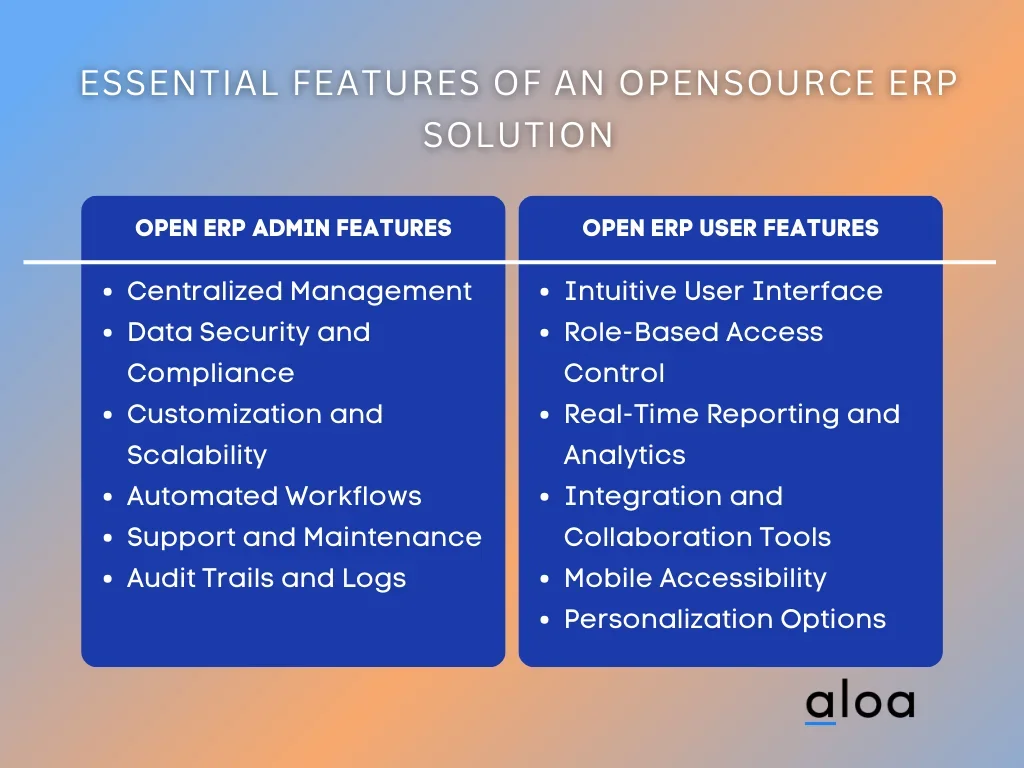
Admin-Side Features of an Opensource ERP Solution
Administrators hold a crucial role in setting up and customizing ERP systems. These systems have specialized features that help streamline their tasks, allowing admins to enhance system performance, address issues effectively, and adjust the ERP to meet changing organizational needs:
- Centralized Management: Tools and functionalities for administrators to centrally manage user access, permissions, and configurations across the entire ERP system.
- Data Security and Compliance: Robust security features ensure data integrity, encryption, regular backups, and compliance with industry regulations and standards.
- Customization and Scalability: Capability to customize modules for human resources management, workflows, and processes to fit the organization's unique needs while being scalable to accommodate growth.
- Automated Workflows: Tools for administrators to create and manage automated workflows, reducing manual intervention and optimizing processes.
- Support and Maintenance: Access to support resources, updates, and maintenance tools to ensure the ERP system runs smoothly and efficiently, resolving issues promptly.
- Audit Trails and Logs: Offering comprehensive logs and audit trails to track system changes, user actions, and data modifications, ensuring transparency, accountability, and compliance within the ERP system.
User-Side Features of an Opensource ERP Solution
When assessing an ERP system from the user's viewpoint, it's vital to analyze how user-friendly, functional, and tailored it is to meet specific operational requirements. Here are essential user-oriented features to take note of:
- Intuitive User Interface: A user-friendly interface that allows easy navigation and accessibility to various modules and functions, ensuring users can operate the system efficiently.
- Role-Based Access Control: Customizable access rights based on user roles, ensuring that users have access only to the modules and data relevant to their job functions.
- Real-Time Reporting and Analytics: Giving users real-time insights and customizable reports to make informed decisions quickly.
- Integration and Collaboration Tools: Seamless integration with other software and collaboration tools (like email, calendars, etc.) to streamline communication and workflows.
- Mobile Accessibility: Accessibility through mobile devices, enabling users to access and manage information on the go, improving productivity and flexibility.
- Personalization Options: Allowing users to customize their interface or dashboard according to their preferences allows for a more personalized user experience and efficient workflow management.
Steps in Choosing the Best Opensource ERP Solution
Choosing the best opensource ERP solution requires a deep dive into your needs and careful evaluation of scalability, integration, customization, user interface, vendor reliability, and costs. Explore our guide for insights on making an informed decision that aligns with your business objectives.
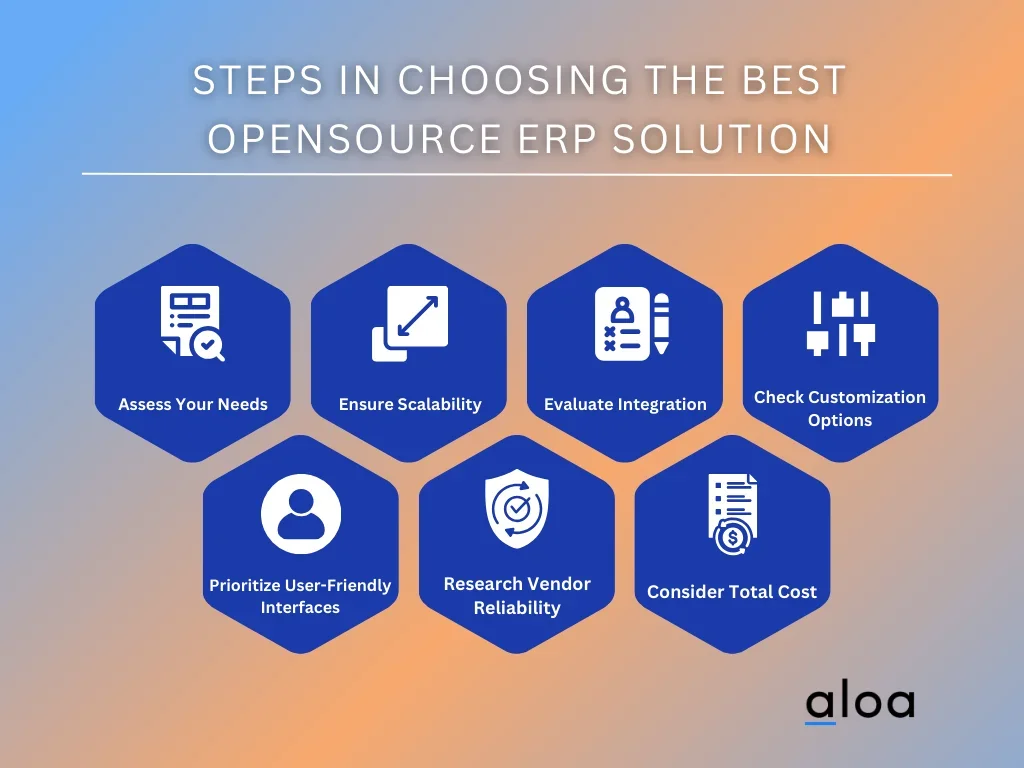
Step 1: Assess Your Needs
Begin by conducting a comprehensive analysis of your business requirements. Engage with key stakeholders and departments to identify pain points, inefficiencies, and areas that need improvement.
Additionally, create a checklist or matrix outlining essential features and functionalities necessary for your operations, and involve department heads, IT personnel, and end-users in this evaluation process. These sample guide questions can help ensure that all essential needs are addressed before choosing the best opensource ERP solution:
- Operational Pain Points: What are your business processes' current inefficiencies or challenges? Where do bottlenecks frequently occur, causing delays or errors?
- Strategic Objectives: What key performance indicators (KPIs) should the ERP help you improve or monitor?
- Flexibility and Scalability: How rapidly do you anticipate business growth in the next 3-5 years? Can the chosen ERP accommodate changes in user count, data volume, and operations without significant disruptions?
- Integration Requirements: What existing systems (e.g., CRM, HR software) should seamlessly integrate with the new ERP?
- Customization Needs: Which business processes or workflows are unique to your organization and might require customization?
- User Experience and Training: What level of user-friendliness should the ERP offer?
Step 2: Ensure Scalability
After assessing your needs, evaluate the ERP's capacity to grow alongside your business. Consider future projections for data volume, user count, and operational complexities. Review the ERP's historical performance in handling increased loads and its ability to scale without significant disruptions.
Moreover, request case studies or references from the ERP vendor demonstrating successful scalability in similar-sized organizations or industries, including educational institutions, manufacturing, healthcare, retail, and service-based sectors. Also, inquire about how the system adapts to increased demands without compromising performance.
Step 3: Evaluate Integration
Next, assess the ERP's compatibility with your existing software systems and tools. Identify potential integration points and analyze the ease and depth of integration capabilities. Check for APIs, data migration tools, and compatibility with your current IT infrastructure.
In addition, create a matrix detailing the integration points between your current systems and the proposed ERP. Ask the vendor for a demonstration or trial period to test integration capabilities with your specific plans. Furthermore, here are the critical elements of an integration matrix that you may consider:
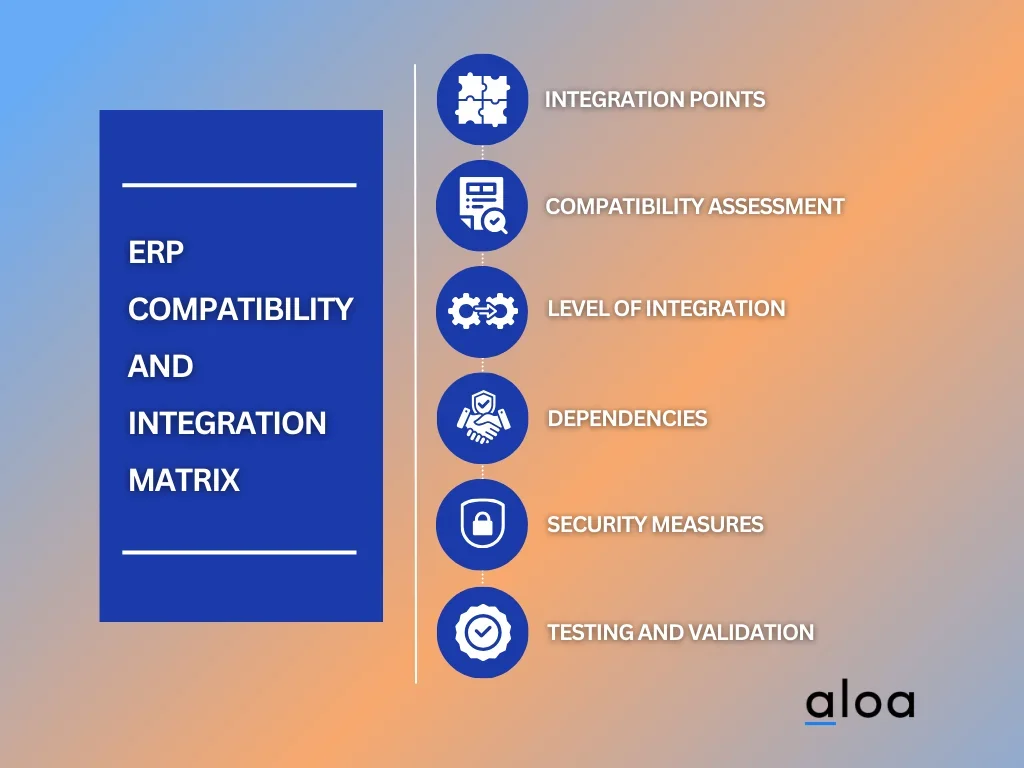
- Integration Points: Specific data or functionalities must interact between the ERP and existing systems. For instance, customer data, sales records, employee details, or financial transactions that require synchronization.
- Compatibility Assessment: This includes checking if the ERP offers specific integration tools or APIs to connect with other software.
- Level of Integration: The degree or frequency of data exchange between systems. It specifies whether integration happens in real-time, through batch processing, periodic synchronization, or scheduled transfers.
- Dependencies: Dependencies determine if specific systems must integrate before others due to data interlinkages or operational dependencies.
- Security Measures: It involves setting up access controls, encryption methods, and other security measures to protect sensitive information during integration.
- Testing and Validation: It includes integration testing plans, data validation methods, system compatibility checks, and reconciliation processes to ensure smooth and error-free integration.
Step 4: Check Customization Options
Then, proceed to investigate the level of customization options. Determine whether the system allows configurations that match your workflows without excessive development or complexities.
Moreover, request a demo focused on customization options. Assess how easily the ERP can be tailored to your needs without requiring extensive programming or additional costs. Furthermore, here are the most common customization options that you may consider:
- User Interface Customization: Tailoring the ERP interface's appearance, layout, and content to match specific user preferences or roles within the organization.
- Workflow Configuration: Modifying or creating new workflows and processes within the ERP to align with unique business practices and operational needs.
- Reporting and Analytics Customization: Customizing reports, dashboards, and data visualizations to display specific KPIs and metrics relevant to the organization's requirements.
- Field Customization: Adding, removing, or modifying fields within forms or screens to capture specific data points essential for business processes.
- Role-Based Access Controls: Setting up and customizing access permissions based on user roles and responsibilities within the ERP system to ensure data security and user-specific functionalities.
Step 5: Prioritize User-Friendly Interfaces
Once you’re done checking the customization options, prioritize user-friendly interfaces. Emphasize the importance of an intuitive interface that minimizes training needs and enhances user adoption. Conduct user experience (UX) tests or demos with sample users from different departments to gauge ease of use and understand potential challenges.
Additionally, organize focus groups or user workshops to gather feedback on the usability of the ERP interfaces. Consider user feedback and incorporate it into your decision-making process.
Step 6: Research Vendor Reliability
Afterwards, investigate the ERP vendor's reputation, track record, and customer support services. Check for certifications, customer reviews, and the vendor's responsiveness to issues and updates. Engage with existing clients or references provided by the vendor.
In addition, prepare a list of questions regarding support response times, update frequency, and their process for handling issues. Request references from the vendor and reach out to these organizations for feedback on their experiences.
Step 7: Consider Total Cost
Finally, calculate the total cost of ownership over a defined period. Consider licensing fees, maintenance costs, training expenses, and any additional costs related to customization or support. Compare these costs against the anticipated benefits and ROI of the ERP solution.
Furthermore, develop a thorough spreadsheet or financial model delineating all foreseeable costs over a defined timeframe, such as five years. Include initial and ongoing expenses to present a coherent overview of the investment's value.
Key Takeaway
Choosing the best opensource ERP solution is crucial for startups, businesses, and enterprises. These systems are designed for managing key business functions like finance, supply chain, and inventory, providing a centralized platform for streamlined operations. Additionally, their strength stems from a robust community of developers continuously enhancing functionalities, ensuring constant evolution and adaptability.
Harnessing the best opensource ERP solution enables businesses to optimize resource allocation, enhance productivity, and reduce operational complexities. They foster a culture of innovation by allowing customization and integration of new functionalities, paving the way for tailored solutions that meet specific business demands.
For more details on refining your business strategies in the dynamic tech industry, don’t hesitate to contact us at [email protected]. We’re committed to empowering your ERP system to seamlessly adapt and thrive alongside your operations, meeting your business's dynamic needs and complexities with our specialized resources.

